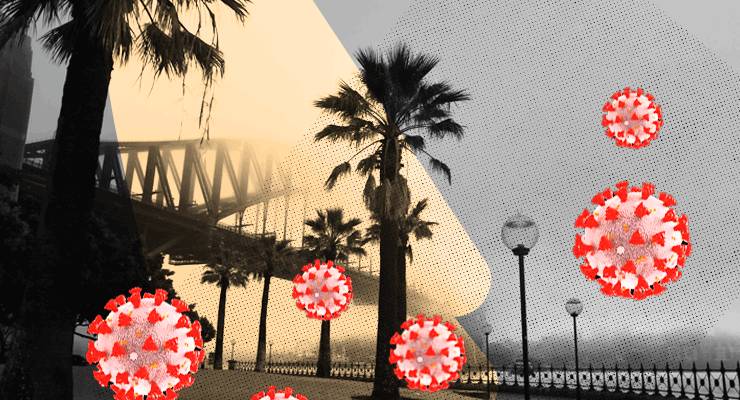
In early 2021, Australia thought it had seen the worst of COVID-19.
Victoria had gone through a brutal 112-day lockdown, and Sydney had narrowly avoided an outbreak over Christmas. We had been lulled into a false sense of security, wrongly believing Australia could stay on top of outbreaks, that vaccines would soon be rolled out across the country and life would return to normal.
But then the Delta variant arrived — two to five times more contagious than previous strains. States were thrown into disarray trying to contain the virus.
There are a number of factors that caused the Delta wave to start its roll: slow lockdowns, premature easing of restrictions, and undetected community circulation.
False starts and scares
Just days before Delta was listed as a variant of concern by the World Health Organization on May 11, Sydney had recorded its first locally transmitted COVID case in over a month. It was the Delta variant, infecting a man in his 50s who tested positive on May 5. He had visited at least 20 locations across the eastern suburbs and had a high viral load, leading to grave warnings from then NSW premier Gladys Berejiklian.
“The world is [in] a very dangerous place and in this case, the eastern suburbs may or may not be,” she said. Worryingly, the source of the man’s infection couldn’t immediately be identified, and sewage testing found COVID fragments in the inner west, showing the virus had been circulating undetected in the community.
But despite the warnings, no cluster emerged and no new daily cases were recorded in the last week of May. As Prime Minister Scott Morrison said at the time, “My fellow Sydneysiders can feel very confident that if anyone can get on top of this without shutting the city down it is the NSW government.”
Chair of epidemiology at Deakin University Professor Catherine Bennett tells Crikey these brushes made cities overconfident.
“We had some stories that were making us feel really, rightly optimistic that you can contain Delta,” she said. “But all it takes is one person.”
Sydney thought it had a handle on the variant, but was soon proved wrong.
NSW is slow to react
On June 16, a limo driver then ineligible for the vaccine who transported international flight crews caused a cluster to emerge in Bondi. Within five days, the cluster had grown to 22 cases. The federal crisis cabinet didn’t meet until June 25, eight days later.
Health Minister Brad Hazzard told a parliamentary inquiry on the government’s management of the pandemic that the eastern suburbs outbreak was similar to the northern beaches cluster over Christmas, which was brought under control with targeted lockdowns in a matter of weeks.
“They responded very well and very quickly … and when those cases went out to [the west] that was not seen initially,” he said.
He was wrong.
Just three days after the limo driver was found to be infectious, a party in West Hoxton in south-west Sydney — which was permitted under restrictions at the time — became a superspreader event, with 21 guests infected (six vaccinated guests were protected). Contact tracers first found out about the party on June 21.
Restrictions were implemented in Sydney but with outdoor recreation permitted and hairdressers and major retail stores still open, Melburnians scoffed at Sydney’s “lockdown light”. The NSW government didn’t lock greater Sydney down until June 26, despite knowing two days earlier that contact tracers had missed a number of party guests who spent days infectious in the community.
Chief health officer Kerry Chant later described the West Hoxton party as “the seeding event in south-western Sydney … that led to the lockdown,” adding it wasn’t recognised as such at the time.
Those days of inaction were crucial. Why the government didn’t take immediate action is still unknown: Hazzard refused to publicly release the documents detailing the advice Chant gave about locking down greater Sydney, saying the formal advice was given on June 25.
Labor’s state Legislative Assembly leader Penny Sharpe, who was on the parliamentary inquiry committee, tells Crikey the refusal was completely left of field as Berejiklian had previously agreed to release the advice.
“They were too slow to lock down early, and without the health advice, we’ve not been able to track down what happened,” she said. “While in the beginning, the premier was focusing on health advice, it’s been clear for a while that hasn’t always been the case.”
Previous measures no longer appropriate
Clusters soon emerged across greater Sydney, at Ocean Foods in Marrickville in the inner west, at a bank in Roselands, and later at the Crossroads Hotel in Casula, in Sydney’s south-west.
But it wasn’t until after July 16 that infections really took off. Infections started spreading across the city to the south-western regions and became out of control.
There are a number of factors for this: workers in the region are more likely to be employed in jobs such as distribution centres, food, logistics and transport where it is impossible to work from home; messaging was poor or didn’t stick in multicultural communities, with NSW employing volunteer translators too late in the outbreak; testing rates were low.
Contact tracers struggled to link cases and get on top of them early, with the number of people who were infectious in the community growing. NSW’s COVID-19 check-in app wasn’t alerting people if they’d been to an exposure site — an issue that still hasn’t been fixed. New daily case numbers more than doubled in the 10 days between July 18 and July 28, topping 239 cases.
Bennett says this caught Sydney by surprise.
“They learnt that their contact tracing wasn’t working,” she said. “They just couldn’t get in front of it.”
She says efforts focused on the first generation of infections, instead of casting a wider net and identifying casual contacts as well as close contacts.
With more than 100 new daily cases recorded in late July, Berejiklian deemed the outbreak a “national emergency“. Rules weren’t being followed; one study estimated just 40% of residents were staying home. Harsher restrictions were introduced in mid-August, shrinking the travel bubble from10 to 5km, with “singles buddies” in areas of concern having to register with the government.
Sydney’s previous good fortune had run out, and previous methods of dealing with outbreaks were inadequate. As Berejiklian conceded in October: “Delta is different.”
Next: How the virus took hold in Melbourne.








Delta is different. However NSW leaders seemed to think that NSW was different, rather than just lucky. Gladys et al, you’re bloody idiots!
From before the Plague Princess first hove into view at Sydney Heads, on that fateful April day in 2020 – as per ancient seafaring convention the captain had advised the ABF of the presence of suspected covid cases and other, undiagnosed flu-like patient/passengers.
Against the Boarding Officer’s instruction to stand-off, inexplicably (not really!), a pratique was issued, the vessel berthed and the sick passengers met by amubulances and carried hither & yon, none can say where except for some CabCharge stubs to the Hillsong complex in northern Sydney.
Berejiklian was a risk taker. Not just with Covid it turns out. However, when it came to Covid she preferred to push the envelope to deliver her Covid-lite strategy. She dodged a Covid-bullet with the Ruby Princess (imagine if the sick had stayed in Sydney to shop, rather than immediately fly out to other places!), and, with SmoCo’s support, took the Bondi event to even greater extremes. What happened next is, sadly, history, carved on headstones, and in people’s hearts.
There needs to be a royal commission into this all once the pandemic passes. It’d be interesting to know if Melbourne could have avoided this mess if the Liberals (both state and federal) had not been so arrogant.
Victoria and Aotearoa New Zealand got delta from NSW (Sydney, to be precise). Yes, a full and detailed enquire is cried out for, but won’t happen, too many pollies and some bureaucrats stand to be shown for what they were…not up to it.
So if it were not for naughty NSW there would have been no Delta outbreak in Melbourne? Seriously? No quarantine leaks, etc?
I tend to agree that there are some double standards in play here. An outbreak in NSW is the NSW govt’s fault; one in Vic or NZ is…also the NSW govt’s fault. That, to me, is illogical.
Even if the initial Delta outbreak in Victoria can be blamed on NSW, it’s absurd to blame the eventual scale of it on NSW.
Proves how fatuous all the trash talking about “mockdowns” ultimately was.
Whilst I don’t like dealing in counterfactuals, maybe? It’s unlikely but the initial outbreak came from Sydney.
That Hazzard refused to reveal Dr Chant’s advice is telling – it tells us Chant’s advice was to shut down – yet even that is not Brad “Health” Hazzard’s biggest foul-up.
The biggest foul-up of all has to be the failure to class these limo drivers is Tier 1 quarantine workers, and mandate vaccination and face masks.
This article states that the limo driver was not eligible for a vaccine. I don’t believe this is correct. As a quarantine worker he was in phase 1. I think he was also over 60 and hence was eligible on an age basis. As reported elsewhere, the issue was that he didn’t want AstraZeneca as he was worried about the risk of blood clots, and he was not wearing a mask. Regardless, surely it was a failure of the NSW Government to allow an unvaccinated worker to be in close contact with arrivals from high risk areas. I suspect complacency was a big factor, but it still means that NSW government has been responsible for two of the three major outbreaks in Australia.
Let’s remember, though, that NSW has had by far the biggest quarantine program and has brought many more Aussies home than the other states – about as many as all the other states put together.
Most commnetators seem to have overlooked the NSW Govt allowing airlines to make their own arrangements for transporting flight crew to quarantine hotels, unlike other States where flight crew transport was an integral part of quarantine.